Raspberry Pi 5 vs. Orange Pi 5 Plus vs. Rock 5 Model B
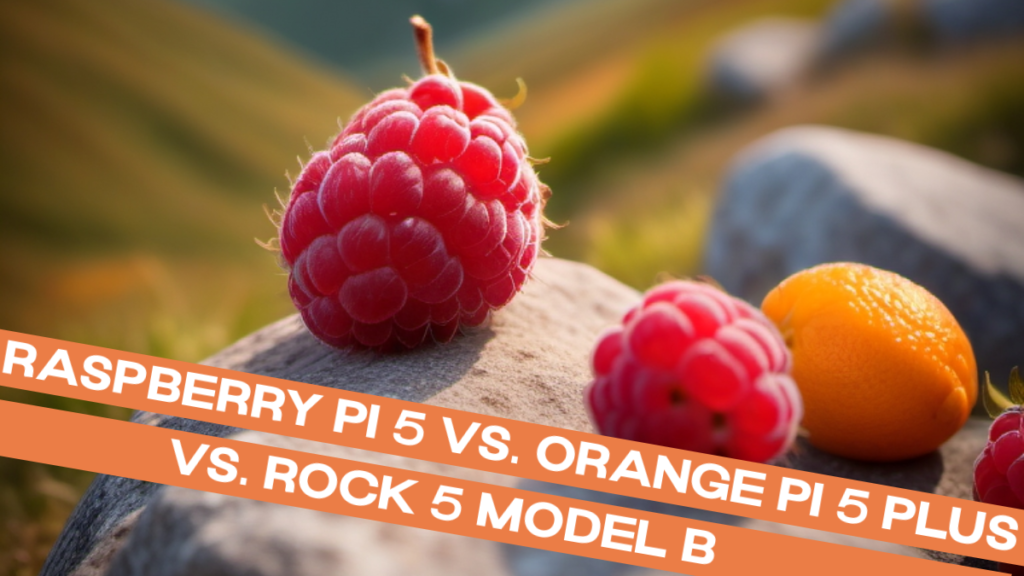
With the announcement of Raspberry Pi 5, a new generation brings a new set of questions – like, how does Raspberry Pi 5 stack up against its competitors? In this article, I want to go over Raspberry Pi 5 vs. Orange Pi 5 Plus vs. Rock 5 Model B.
I have a confession. My first Pi was actually an Orange Pi that I purchased in Moscow in 2015. I was looking to set up a Pi-Hole on my home router. At that time and in that location, it was much cheaper to get an Orange Pi than a Raspberry Pi.
Ever since, I’ve dutifully followed the developments of both Orange Pis and Raspberry Pis.
So, now that Raspberry Pi have released a new generation, I feel like the time has come to compare these two against each other. However, that wouldn’t do justice to the Rock 5 Model B, which belongs in the same category.
So here, in this article, I want to compare and contrast these three SBCs.
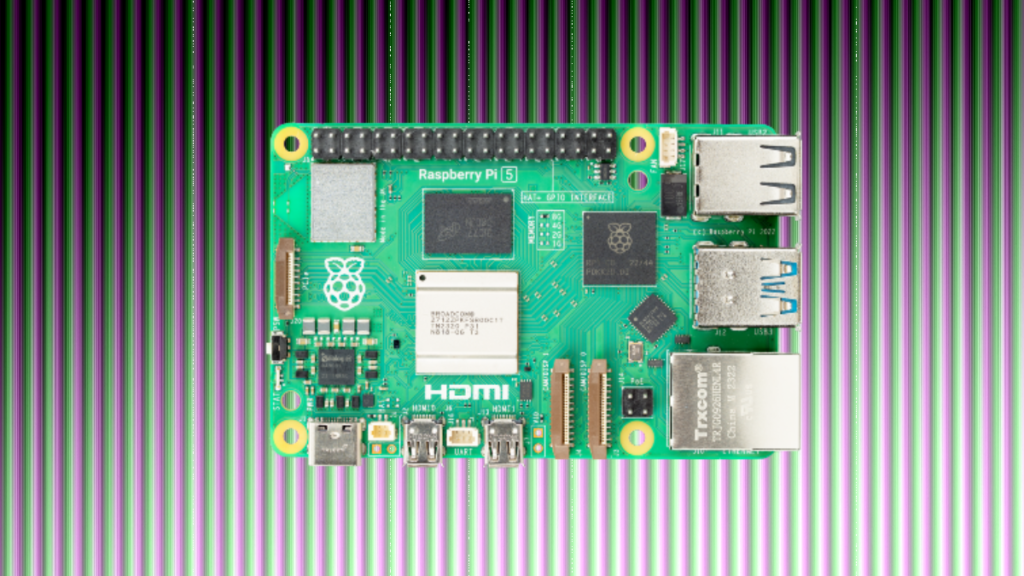
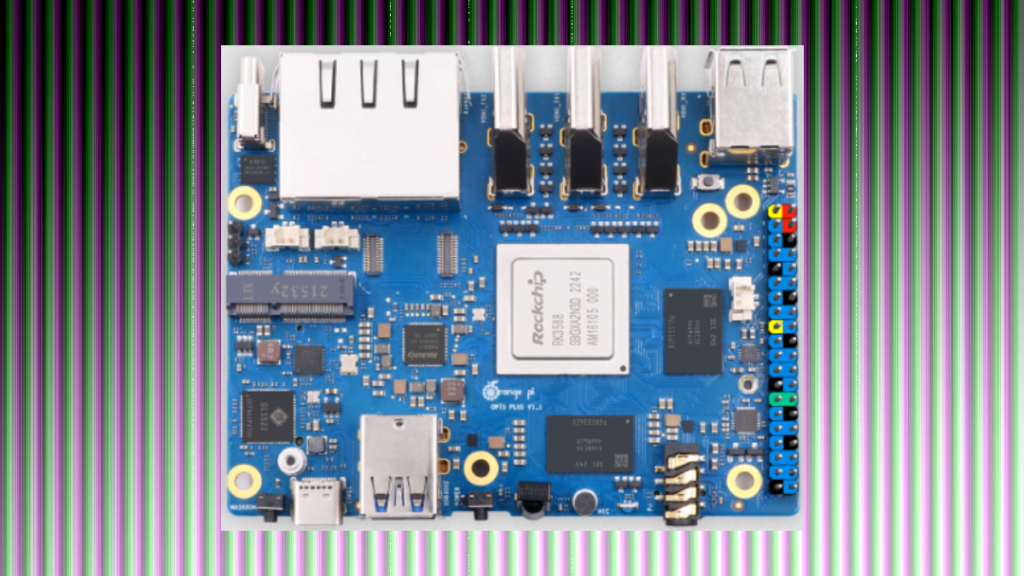
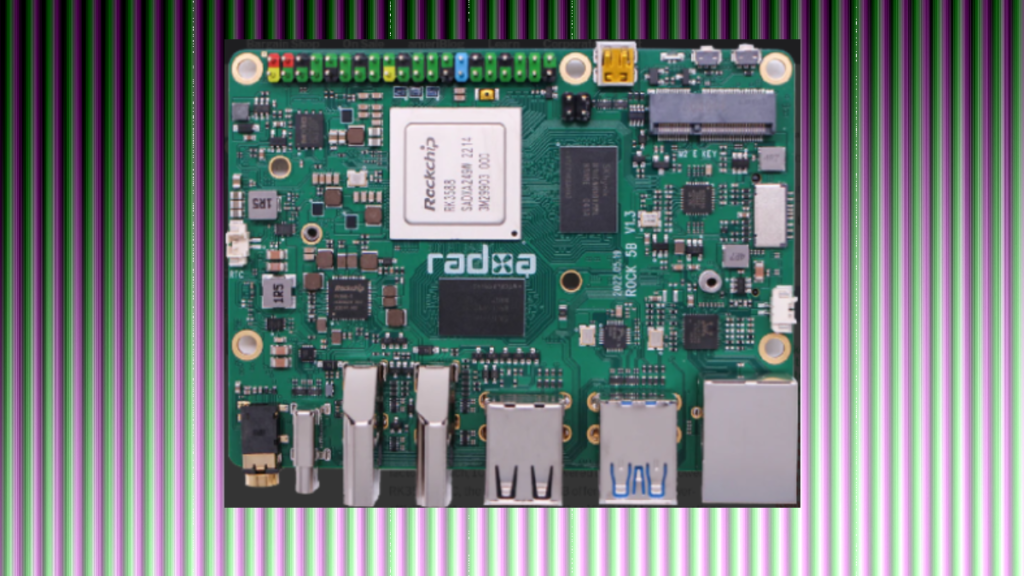
Specs
So, first, let’s take a look at some of the specs.
| Raspberry Pi 5 | Orange Pi 5 Plus | Rock 5 Model B | |
| SoC | BCM2712 | RK3588 | RK3588 |
| CPU | 4x ARM Cortex-A76 | 4x ARM Cortex-A76 4x ARM Cortex-A55 | 4x ARM Cortex-A76 4x ARM Cortex-A55 |
| GPU | VideoCore VII | ARM Mali-G610 MP4 | ARM Mali-G610 MP4 |
| RAM | 4/8GB LPDDR4X | 8/16/32GB LPDDR4X | 2/4/8/16/32GB LPDDR4X |
| Process Nodes | 16nm | 8nm | 8nm |
| Storage | 1x PCIe 2.0 micro SD card | eMMC 1x M.2 (E Key) 1x M.2 (M Key) micro SD card | eMMC 1x M.2 (E Key) 1x M.2 (M Key) micro SD card |
| Network | 1Gb Ethernet 2.4 GHz and 5.0 GHz 802.11ac Wi-Fi Bluetooth 5.0/BLE | 2x 2.5Gb Ethernet ports (No onboard WiFi or Bluetooth) | 2.5Gb Ethernet (No onboard WiFi or Bluetooth) |
| Video | 2x micro HDMI (4Kp60) 2x MIPI DSI/CSI | 2x HDMI(8Kp60) 1x HDMI input (4Kp60) 1x MIPI DSI 1x MIPI CSI | 2x HDMI(8Kp60) 1x micro HDMI input (4Kp60) 1x MIPI DSI 1x MIPI CSI |
| Audio | no audio jack | audio jack onboard microphone | audio jack |
| USB | 2x USB 2.0 2x USB 3.0 | 2x USB 2.0 2x USB 3.0 1x USB 3.0 Type C | 2x USB 2.0 2x USB 3.0 |
| Power | 5V/5A (USB-C) | 5V/4A (USB-C) | 5V/5A (USB-C) |
| Size | 94x62mm | 100x70mm | 100x70mm |
| Power button | ✓ | ✓ | ✓ |
| RTC | ✓ | ✓ | ✓ |
Summarizing the Specs
The first thing to point out is that Raspberry Pi 5 distinguishes itself from Orange Pi 5 Plus and Rock 5 Model B in the SoC.
While Raspberry Pi 5’s Broadcom BCM2712 has a four-core ARM Cortex-A76 setup with a VideoCore VII GPU, Orange Pi and the Rock have RockChip’s RK3588, which has eight cores and an ARM Mali-G610 MP4 GPU.
These eight cores are notable on the RK3588, because four of them are also ARM Cortex-A76, while the other four are ARM Cortex-A55.
Another thing that quickly jumps out are the differences in RAM sizes. At launch, Raspberry Pi 5 will have 4GB and 8GB variants (with 2GB on the way and potentially 1GB in the future). I’ve also seen discussion about a potential 16GB variant, but nothing official.
By contrast, Orange Pi 5 Plus pushes upwards with 8GB as the lower variant and then 16GB and 32GB at the top. From what I’ve seen, Rock 5 Model B has the largest range with 2, 4, 8, 16, and 32GB options.
When it comes to storage, all three SBCs have micro SD card slots.
But Orange Pi 5 Plus and Rock 5 Model B also come with M.2 M Key and E Key slots. These allow you to hook up a WiFi module (as neither board has onboard WiFi) and boot up via an NVMe SSD. They also come with eMMC sockets.
Raspberry Pi 5 does not come with M.2 slots or eMMC sockets. However, with the PCIe 2.0 lane output, booting up via NVMe SSD is now possible.
When it comes to networking, Raspberry Pi 5 comes with onboard WiFi at 2.4 GHz and 5.0 GHz 802.11ac along with Bluetooth 5.0 and Bluetooth Low Energy (BLE). As I mentioned above, Orange Pi 5 Plus and Rock 5 Model B have M.2 E Key slots and they both provide modules that can get WiFi 6 and Bluetooth 5.2.
All you need to do is install the modules yourself.
When it comes to video, there’s a big difference between the three.
Raspberry Pi 5 has two onboard micro HDMI ports that can provide 4Kp60 simultaneously. Additionally, it has two MIPI sockets that can both be used for camera and display.
Orange Pi 5 Plus has two onboard full HDMI ports that can provide up to 8Kp60 and a full HDMI port for input that can provide up to 4Kp60. Additionally, it has one MIPI socket for camera and a separate MIPI socket for display.
Rock 5 Model B has two onboard full HDMI ports that can provide up to 8Kp60. But it then has a micro HDMI port for input that provides up to 4Kp60. Like the Orange Pi though, it has one dedicated MIPI socket for camera and a separate MIPI socket for display.
Raspberry Pi made the decision to do away with the audio jack for the new model. Orange Pi 5 Plus and Rock 5 Model B both have audio jacks.
Furthermore, Raspberry Pi 5 comes with two USB 2.0 ports and two USB 3.0 ports, as well as the USB-C port for power. Orange Pi 5 Plus, however, comes with two USB 2.0 ports, two USB 3.0 ports, a USB-C port for power, and a USB 3.0 Type-C port. Rock 5 Model B has two USB 2.0 ports, two USB 3.0 ports, and a USB-C port for power that can also function as a DisplayPort output.
They do share some features. Although the three boards have slightly different power supplies, all rely on USB-C. They all have power buttons and RTCs.
One notable thing though, before we move on to benchmarks, is the form factor.
Raspberry Pi 5 remains within the standard Raspberry Pi flagship family with a roughly 90mm x 60mm size. Orange Pi 5 Plus and Rock 5 Model B, however, are observably larger. They are roughly 100mm x 70mm (also called the Pico ITX form factor).
Benchmarks
At first, I thought about setting up my own benchmarks for these three boards. But after some thought, I decided that Jeff Geerling actually provided all the important benchmarks in his recent video on Raspberry Pi 5.
So, although he uses Orange Pi 5 and not Orange Pi 5 Plus, I think these are the benchmarks you can reliably expect from these three different SBCs. Jeff also includes Raspberry Pi 4, so you can see how much more powerful Raspberry Pi 5 is.
First, let’s take a look at the HPL benchmark, which measures the floating-point computing power of all three boards.
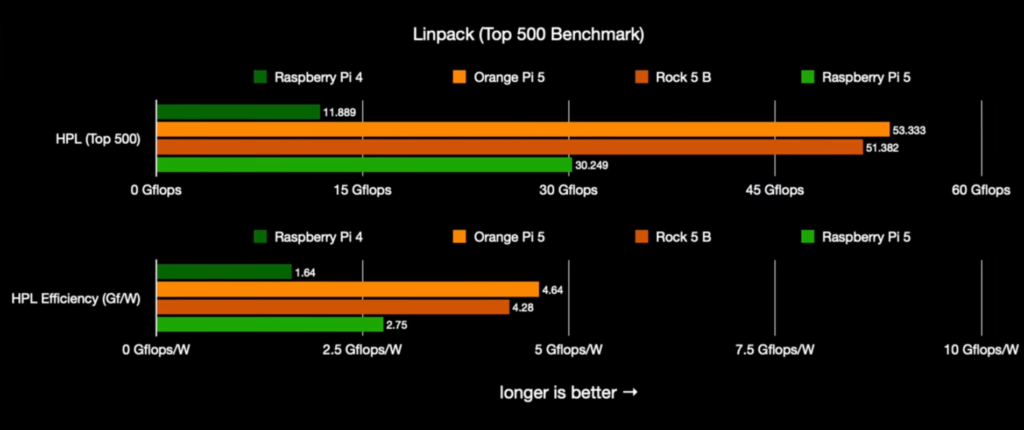
These benchmarks measure how quickly each SBC can solve dense linear equations. You’ll notice that Orange Pi 5 and Rock 5 Model B blow the Raspberry Pis out of the water. Orange Pi 5 and Rock 5 Model B have over 50 GigaFLOPS, or 50 billion floating point operations per second.
Meanwhile Raspberry Pi 5 comes in at around 30 GigaFLOPS.
The efficiency of Orange Pi 5 and Rock 5 Model B is pushing double the efficiency of Raspberry Pi 5. Efficiency, in this context, refers to how well it performs the HPL benchmark compared to its theoretical peak performance.
Raspberry Pi 5 comes in at 2.75 GigaFLOPS per Watt, while Rock 5 Model B comes in at 4.28 GigaFLOPS per Watt. Meanwhile, Orange Pi 5 comes in at 4.64 GigaFLOPS per Watt!
Jeff then turns to two benchmarks that I really appreciate. Namely, how long it takes each board to encode MP3 and how long it takes to compile the Linux kernel.
In the first case, Raspberry Pi actually outperforms Orange Pi 5 and Rock 5 Model B. It converts WAV files to MP3 files in under 12 seconds. Orange Pi 5 and Rock 5 Model B, on the other hand, both take slightly more than 12 seconds.
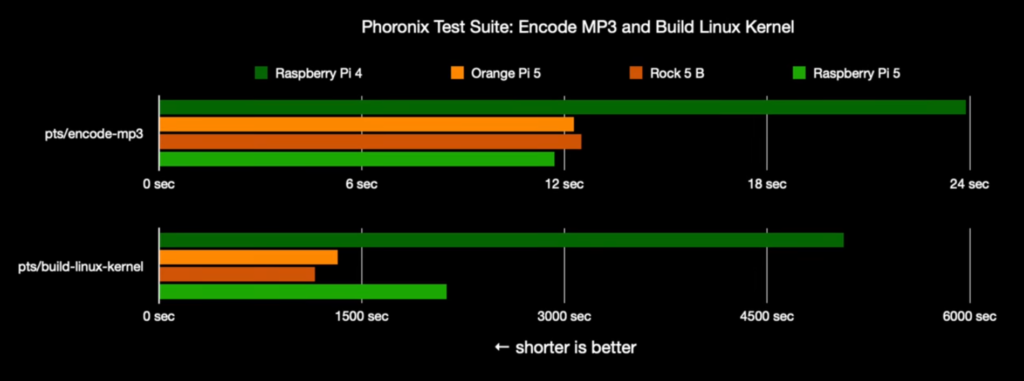
However, when compiling the Linux kernel, Orange Pi 5 and Rock 5 Model B leave Raspberry Pi 5 in the dust by managing to do it in well under 1500 seconds. Raspberry Pi 5 comes in at around 2000 seconds.
But there are some more benchmarks worth noting.
When it comes to video encoding, Raspberry Pi 5 performs much closer to Orange Pi 5 and Rock 5 Model B. Looking at media encoding for 4K video, all three hover around 3.75 frames per second (with Raspberry Pi 4 hitting something around 1.5 frames per second).
However, Orange Pi 5 and Rock 5 Model B outperform Raspberry Pi 5 with video encoding for 1080p video. They both are well above 20 frames per second, while Raspberry Pi 5 doesn’t quite reach 18 frames per second.
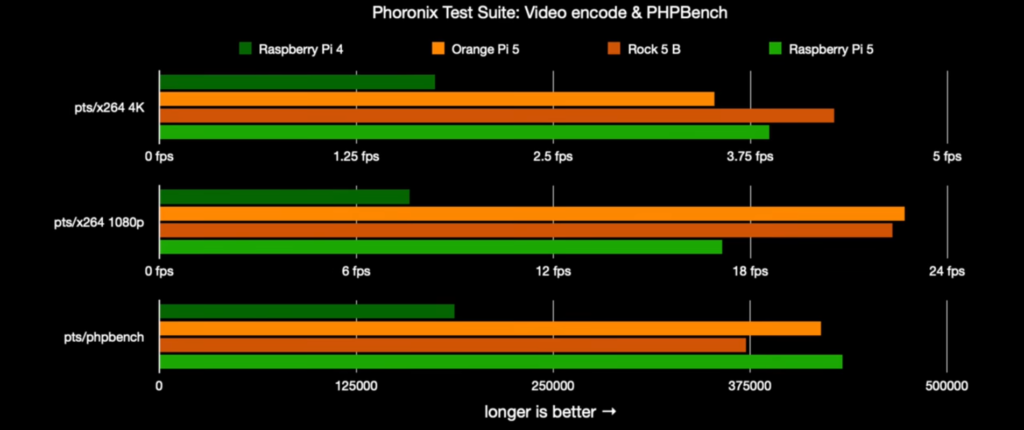
However, the PHP benchmark on Raspberry Pi 5 actually beats both Orange Pi 5 and Rock 5 Model B.
Nevertheless, I would say that Orange Pi 5 and Rock 5 Model B pretty solidly outperform Raspberry Pi 5 in most of the important benchmarks. And, of course, considering their sizes and prices, this isn’t really all that surprising.
As Jeff puts it in his video, “The Pi 5 isn’t the SBC performance king, but it keeps Pi in the race this generation…”
Prices
Now, one of the chief differences between the three SBCs is the price. Indeed, it’s clear that Raspberry Pi traded in a certain amount of performance in order to keep costs down.
When talking about SBCs, people often give you the official price point. They’ll say that a Raspberry Pi 5 for 8GB costs $80, for example. But then you’ll never find a Raspberry Pi 5 at that price. That’s because this is the official price and doesn’t include shipping, taxes, or currency fluctuations.
So I thought I would dive into price a little bit differently.
I want to look at real prices.
But this also means looking at how these companies sell their products officially, because if you simply let the market decide the price, then things can get both expensive and unreliable fairly quickly.
Please keep in mind that I’m in Germany, so I’ll be giving you prices in Euros.
First of all, if you want to buy an Orange Pi 5 Plus, the company itself directs you to Amazon or AliExpress.
The price that I found at AliExpress for the Orange Pi 5 Plus with 16GB of RAM is 153.27€.
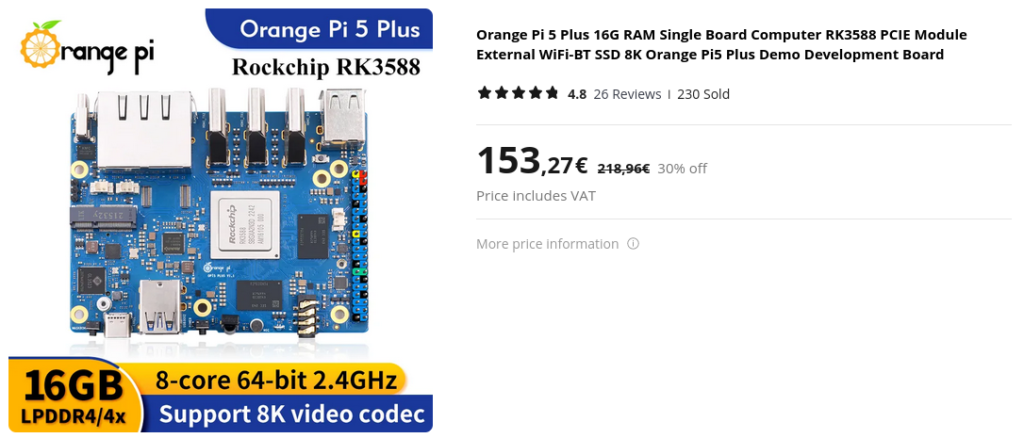
If you want to buy a Rock 5 Model B, things are set up a bit differently. Radxa, the company behind Rock 5 Model B, has what it calls “authorized distributors”. As far as I can tell from their website, there are four: OKDO, Allnet, 3Logic, and Ameridroid.
Again, I’m in Germany, so I went to the Allnet site for Germany and found this:

The Rock 5 Model B with 16GB is 301.63€.
Now here’s a problem – I haven’t been able to find an Orange Pi 5 Plus or a Rock 5 Model B with 8GB for sale. And there currently isn’t a variant of Raspberry Pi 5 with more than 8GB, so comparing prices here is a little wonky. But it’s worth seeing what’s available and what isn’t.
Raspberry Pi is similarly structured to Radxa, but with a much broader reach. Raspberry Pi has what they call “approved resellers” (and, full disclosure, we are an approved reseller of Raspberry Pis).
You’ll know if you come across an approved resellers website, because they’ll have a logo that looks like this:

Anyway, we’re selling Raspberry Pi 5s for 93.30€ at our sister company – buyzero.de. That’s notably cheaper than the other two, but it’s also a question of what you’re looking for.
You could say that we’re comparing raspberries and oranges.
Jokes aside, if you need more than 8GB of RAM, then going with Raspberry Pis doesn’t make sense at the moment. However, if you’re looking for a cheaper price, then Raspberry Pis are obviously the way to go.
| Raspberry Pi 5 (8GB) | Orange Pi 5 Plus (16GB) | Rock 5 Model B (16GB) | |
| Price | 93.30€ | 153.27€ | 301.63€ |
One thing worth pointing out is also the compatibility of software and the breadth of the community.
Obviously, the Raspberry Pi ecosystem and community is much stronger than the Orange Pi or Rock communities. However, I can basically promise you that the Orange Pi community and Rock community will both grow in coming years.
So these are all things to keep in mind before you buy an SBC.
If you have anything to add, let me know in the comments!
And now, don’t forget about our contest – in which we’re giving away a full Raspberry Pi 5 kit to the winner!
Contest & Newsletter
We know how frustrating it is to have to wait until October 23rd for a Raspberry Pi 5.
So we wanted to make it possible for you to play around with one as soon as possible.
So we’ve set up a contest: What’s the craziest thing you can come up with for Raspberry Pi 5?

Provided your idea doesn’t destroy it, you can send us your idea and we’ll enact it on ours. And we’ll write an article about it!
We’ll announce the winner here and on buyzero.de on October 23rd.
The winning idea (determined by us) will win a full Raspberry Pi 5 kit. This includes a 27W USB-C Power Delivery (PD) Power Supply, a Raspberry Pi 5 case, an SD card, and a Raspberry Pi 5. All with free shipping within the EU.
The runner-up will win a Raspberry Pi 5 with free shipping within the EU.
So be sure to send in your ideas. You can go to the following link for more information: WIN A FREE RASPBERRY PI 5!
Conclusion
So when it comes to specs and benchmarks, Orange Pi 5 Plus and Rock 5 Model B both clearly have the upper hand. However, Raspberry Pi clearly traded performance for cost.
After shipping and tax though, is a Raspberry Pi 5 really that much cheaper than an Orange Pi 5 Plus?
It surely depends on where you live and what deals you can find. What do you think?
I honestly am a fan of all three SBCs, but they all have their respective times and places. Anyway, is there anything I forgot? Let me know!
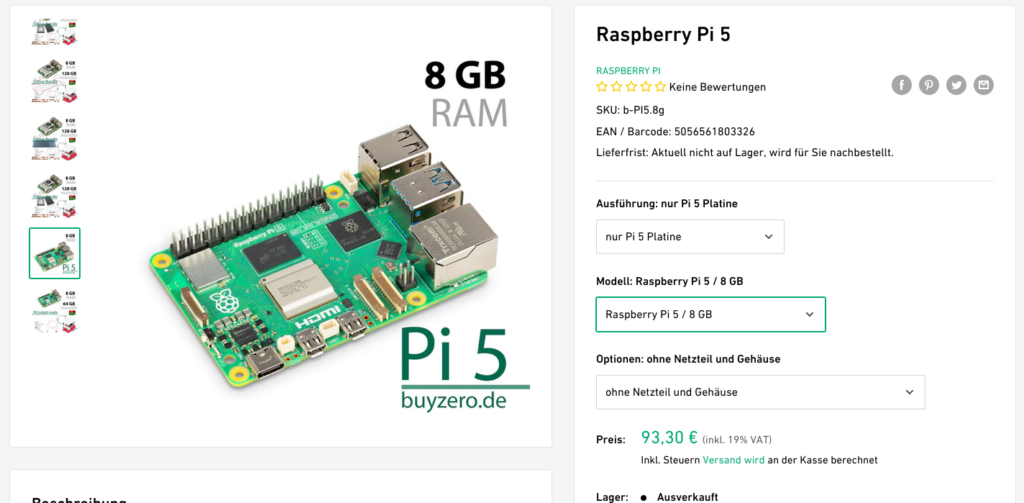
hello Adam,
I don’t know how You were able to get such prices, but wuick search gives okdo de site with €189 for 16G version of Rock 5B, 8G is €153 for now. This is also stock, regular price and okdo from time to time gives some discounts, haloween discount last year was 20% off and also radxa initially launched -$50 on preorders.
Absolutely the best option so far is friendlyelec with nano-pc t6. It’s something like Rock 5B and opi 5+, but with included slot for LTE (for one usb3 port) and option with soldered eMMC that is only few bucks more. At $179 you will get 16G RAM, 256GB eMMC and great cnc passive cool case.
To sum this up.. radxa products are just expensive, but also discounted from time to time. FriendlyElec has always best value while orange pi has cheapest base specs product.
For fair comparison You may consider to add case, cooling, power adapter and some storage option. As for now for Pi5 You also need special pd charger as well as cable that can do 5V 5A. In future also pcie to m.2 adapter not needed anywhere else. Sonner or later You will see that their price model charges more for accessories when others just follow standards not requiring to buy anything else on launch.
Im sure that pi5 will change several things on market and rockchip and amlogic should do their anwers for that. For now pi5 is more like RK3588s boards in some aspects better and on some not.
orange Pi all day. Pi 5 sucks. 1gbE is pathetic man. absolutely detestable decision.
Sorry, but I have to disagree. I found the online support for OPi to be sadly lacking, Ubuntu especially was not well supported, and the people were unfriendly and unhelpful. EX: I say I have a problem with Ubuntu, and all I get is that I shouldn’t use Ubuntu, I should use [fill in the blank]; NOT HELPING! One person suggested some code to try, and if I had tried it, I would have erased my HDD. Extremely NOT HELPFUL!
In other words, it isn’t just about the SBC, it’s about the SBC owners.
> it’s about the SBC owners
Some people aren’t cut-out for the blood, the guts, the mud, the tears, the pain, the fight and the glory of open source on niche ARM SBCs.
Some people can find things that don’t work, then fix them to contribute to the community. Others can only drag the community down with demands, whining, bullying and threats. Yes, there’s broken software (and hardware) every where.
Any incremental step we can take away from the computing-kraken oligopolies is likely to be preferable. Let’s put our money to companies that at least try to respect our rights as individual human beings.
I find these prices astonishingly high for what u are getting. I much prefer to go for an Odroid H3+ or N2+. I get it that the H3 form factor is a little larger but u get 2 SATA ports, loads of cpu clout and a very efficient power utilisation
hi Adam,
thank you for this great comparision.
Just adding up three points:
– the two rockchip based SBC offer a way faster NVMe connectivity (PCIe 3.0 x4 lanes vs a declared PCIe 2.0 x1 – and experimental PCIe 3.0 x1 – of the raspi 5b)
– Wired speed is 2.5 vs 1 Gbps (there is a reference on the main table but not in the article)
– Radxa and Raspi has a theoretical PoE support (not found a card sofar) while Orange pi not. PoE level is to be determined, although it seems Raspberry supports 13W 802.3af PoE and 25W 802.3at PoE+
I don’t think it is fair to compare prices of Orange Pi plus vs RPi. I think it would be much more fair to compare Orange Pi vs RPi. In that case, Orange Pi blows RPi out of the water while being available at Amazon Prime with very quick shipping.
Hi, do you think for a Plex server, the Orange or the Rock will be able to handle streaming and transcoding better than a NAS drive with a Celeron CPU .
Nope. Hw acceleration is not supported for the rockchip (yet). Encoding is but an option.
Not true, with ubuntu based distros is supported, I have a plex running with 2x 4tb external ssd and 2tb internal + 256 Gb on nvme for files that I need when thing is booting, all work fine.
Orange Pi 5 plus has micro sdcard slot too.
Yes, good catch – thanks!
I am so surprised that nobody has valued wireless connectivity of RPi5. Both 802.11ac WiFi and BT5 are so necessary for a SBC.
both are very easily added via usb or mini-pcie if desired
On Orpi5+ you have a dedicated wifi 6 bt 5.4 M2 card for less as 15 USD shipping included, it also carry IR sensor for a remote conroler and has HDMI in port!
I will never ever buy a Raspberry Pi again.
Their performance is just so incredible bad.
What is competely missing in this comparison is software support and quality. The rk3588 boards are very fast, true, but the software quality is very low. You have the choice between hastily assembled hacky and outdated Android or Linux, and 3rd party providers that have a hard time providing clean support. In that domain and in community support the Raspberry blows the competitors out of the window.
Good point, Panca – I agree 100%.
What?!?!
What on earth (or anywhere else) are you talking about?
That just isn’t how it works.
Where do you get this nonsense???
It is the same software, and I very much doubt “hastily assembled hacky and outdated…” is even remotely true.
Do you have any sort of evidence to support your baseless assertions? No? None? Not even one example you can provide? I didn’t think so.
Entirely true. I’ve downloaded several hundred gigabytes of their rk** developer kit. I was surprised by the haste it protruded. Well it all works right? Maybe contributors are to few.
Thank you for reposting the benchmarks. I have seen the Orange Pi 5 listed as RK3588S and the plus as RK3588. These are different versions of the processor with different performances. If they do have different processors, then doing an addition set of benchmarks may be useful.
I would also suggest comparison w/ an Intel N100 (the RK3588 kicks it ass on Passmark, and blows most i3 and some Celeron and other lower end Intel CPUs out of the water).
But you need to add that (and that is about $20 in US via Amazon) to the cost of the build. If there were affordable WiFi 6/BT/5G that would work (and finding HCL for Orange Pi 5 for peripherals is no easy feat, and their customer service doesn’t always respond to questions about things like what other company’s camera modules work), that would be even a better way to go (I can get unlimited 5G internet for about $50/mo).
As far as benchmarks, might want to try Steam and see if you can run a Windows title using Steam’s WINE. While I don’t think the Playstation5 is going to be worried, if you can run Steam games, and other, with reasonable performance (>30FPS, ideally 60-100; I don’t know that the human eye can tell much above 60, which is right at the edge of how fast the retina can refresh).
Finally, one other issue is operating system selection. With RPi there was a growing number of Linux distributions (and I think even Windows, if you do that sort of thing) for RPi, I don’t think loading openSUSE w/ LXQt (my current preferred RPi desktop OS) on Orange Pi is going to be a lot of fun.
Orange PI seems to have an Arch based distro that has built-in support for Android (and if WINE works, then Windows too.) This would give you access to a wide range of titles, some of which might actually have a useful UI on a desktop (e.g. software designed to work with Samsung’s desktop mode). I am not 100% sure why mainstream Linux distro’s don’t provide Android app options (you can DIY) as it would be a pretty large increase in the number of software titles (although, I must admit, I have not yet tested every application available to me in just the openSUSE repositories–over 400K I think, so it will take some time). Being able to pull from Debian (only distro w/ more packages than openSUSE) was always a plus w/ the RPi, as a lot of packages were ported. OpenSUSE, which has a multi-target build system (that other distros use), lets a repository manager just pick what platforms to build for, including Arm64 (or Arm8, RISC, PowerPC, IBM Z series, etc.) so there were a lot of RPi options (plus, its my day to day desktop OS)